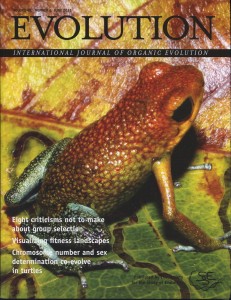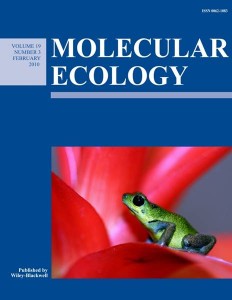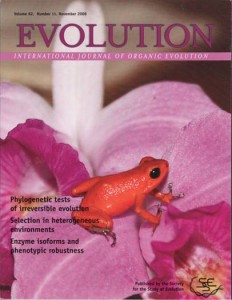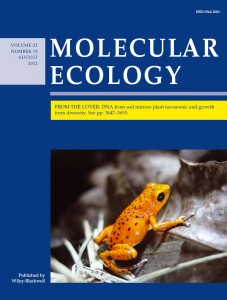An up-to-date list can also be found on Ian’s Google Scholar profile.
* Lab postdocs are in green, grad students in purple, and undergrads in blue.
2023
60. Chambers E.A., Bishop A.P., and Wang I.J. (in press) Individual-based landscape genomics for conservation: an analysis pipeline. Molecular Ecology Resources. [link]
59. Nachman M.W., Beckman E.J., Bowie R.C.K., Cicero C., Conroy C.J., Dudley R., Hayes T.B., Koo M.S., Lacey E.A., Martin C.H., McGuire J.A., Patton J.L., Spencer C.L., Tarvin R.D., Wake M.H., Wang I.J., et al. [103 additional authors] (in press) Specimen collection is essential for modern science. PLOS Biology. [link]
58. Westeen E.P., Escalona M., Beraut E., Marimuthu M.P.A., Nguyen O., Fisher R.N., Toffelmier E., Shaffer H.B., and Wang I.J. (2023) A reference genome assembly for the continentally distributed ring-necked snake, Diadophis punctatus. Journal of Heredity, 114: 690-697.
57. Westeen E.P., Martinez-Fonseca J., d’Orgeix C., Walker F., Sanchez D., and Wang I.J. (2023) Dietary niche partitioning of three Sky Island Sceloporus lizards as revealed through DNA metabarcoding. Ecology and Evolution, 13: e10461. [link]
56. Wogan G.O.U., Yuan M.L., Mahler D.L., and Wang I.J. (2023) Hybridization and transgressive evolution generate diversity in an adaptive radiation of Anolis lizards. Systematic Biology, 72: 874-884. [link]
55. Westeen E.P., Martinez-Fonseca J.G., Chen H., and Wang I.J. (2023) Phenotypic diversity facilitates niche partitioning in a sky island assemblage of spiny lizards. Biological Journal of the Linnean Society, 140: 589-605. [link]
54. Westeen E.P., Escalona M., Holding M., Beraut E., Fairbairn C., Marimuthu M.P.A., Nguyen O., Perri R., Fisher R.N., Toffelmier E., Shaffer H.B., and Wang I.J. (2023) A genome assembly for the southern Pacific rattlesnake, Crotalus oreganus helleri, in the western rattlesnake species complex. Journal of Heredity, 114: 681-689.
53. Bishop A.P., Westeen E.P., Yuan M.L., Escalona M., Beraut E., Fairbairn C., Marimuthu M.P.A., Nguyen O., Chumchim N., Toffelmier E., Fisher R.N., Shaffer H.B., and Wang I.J. (2023) Assembly of the largest squamate reference genome to date: the western fence lizard, Sceloporus occidentalis. Journal of Heredity, 114: 521-528.
52. Bishop A.P., Chambers E.A., and Wang I.J. (2023) Generating continuous maps of genetic diversity using moving windows. Methods in Ecology and Evolution, 114: 521-528. [link]
51. Yuan M.L., Jung C., Frederick J., Fenton C., de Queiroz K., Cassius J., Williams R., Wang I.J.§, and Bell R.C.§ (2023) Parallel and non-parallel phenotypic responses to environmental variation across Lesser Antillean anoles. Evolution, 77: 1031-1042. [§ Indicates co-senior authorship.]
50. Thompson A., Kapsanaki V., Liwanag H.E.M., Pafilis P., Wang I.J., and Brock K.M. (2023) Some like it hotter: differential thermal preferences among lizard color morphs. Journal of Thermal Biology. [link]
49. Hall L.A., Wang I.J., Escalona M., Beraut E., Sahasrabudhe R., Nguyen O., Chumchim N., Toffelmier E., Shaffer H.B., and Beissinger S.R. (2023) Reference genome of the black rail, Laterallus jamaicensis. Journal of Heredity, 114: 436-443.
48. Hall L.A., Wang I.J., Escalona M., Beraut E., Sahasrabudhe R., Nguyen O., Chumchim N., Toffelmier E., Shaffer H.B., and Beissinger S.R. (2023) Reference genome of the Virginia rail, Rallus limicola. Journal of Heredity, 114: 428-435.
47. Richmond J.Q., McGuire J.A., Escalona M., Marimuthu M.P.A., Nguyen O., Sacco S., Beraut E., Toffelmier E., Fisher R.N., Wang I.J., and Shaffer H.B. (2023) Reference genome of an iconic lizard in western North America, Blainville’s horned lizard, Phrynosoma blainvillii. Journal of Heredity, 114: 410-417.
2022
46. Yuan M.L., Westeen E.P., Wogan G.O.U., and Wang I.J. (2022) Female dewlap ornaments are evolutionarily labile and associated with increased diversification rates in Anolis lizards. Proceedings of the Royal Society B, 289: 20221871.
45. Yuan M.L., Frederick J.H., McGuire J.A., Bell R.C., Smith S.R., Fenton C., Cassius J., Williams R., Wang I.J., Powell R., and Hedges S.B. (2022) Endemism, invasion, and overseas dispersal: the phylogeographic history of the Lesser Antillean frog, Eleutherodactylus johnstonei. Biological Invasions, 24: 2707-2722.
44. Grismer J., Escalona M., Miller C., Beraut E., Fairbairn C., Marimuthu M.P.A., Nguyen O., Toffelmier E., Wang I.J., and Shaffer H.B. (2022) Reference genome of the rubber boa, Charina bottae (Serpentes: Boidae). Journal of Heredity, 113: 641-648.
43. Wood D.A., Richmond J.Q., Escalona M., Marimuthu M.P.A., Nguyen O., Sacco S., Beraut E., Westphal M., Fisher R.N., Vandergast A.G., Toffelmier E., Wang I.J., and Shaffer H.B. (2022) Reference genome of the glossy snake, Arizona elegans occidentalis, a declining California species of special concern. Journal of Heredity, 113: 632-640.
42. Shaffer H.B., Toffelmier E., Corbett-Detig R.B., Escalona M., Erickson B., Fiedler P., Gold M., Harrigan R.J., Hodges S., Luckau T., Miller C., Oliveira D.R., Shaffer K.E., Shapiro B., Sork V.L., and Wang I.J. (2022) Landscape genomics to enable conservation actions: the California Conservation Genomics Project. Journal of Heredity, 113: 577-588. [Editor’s Choice]
41. Todd B.D., Jenkinson T.S., Escalona M., Beraut E., Nguyen O., Sahasrabudhe R., Scott P.A., Toffelmier E., Wang I.J., and Shaffer H.B. (2022) The reference genome of the northwestern pond turtle, Actinemys marmorata. Journal of Heredity, 113: 624-631.
2021
40. Terasaki Hart D.E., Bishop A.P., and Wang I.J. (2021) Geonomics: forward-time, spatially explicit, and arbitrarily complex landscape genomic simulations. Molecular Biology and Evolution, 38: 4634-4646.
39. Medina R., Wogan G.O.U., Bi K., Termignoni-García F., Bernal M.H., Jaramillo-Correa J.P., Wang I.J., and Vázquez-Domínguez E. (2021) Phenotypic and genomic diversification with isolation by environment along elevational gradients in a neotropical treefrog. Molecular Ecology, 30: 4062-4076.
2020
38. Yuan M.L., Jung C., Wake M.H., and Wang I.J. (2020) Habitat use, interspecific competition, and phylogenetic history shape the evolution of claw and toepad morphology in Lesser Antillean anoles. Biological Journal of the Linnean Society.
37. Cao Y.-N., Zhu S.-S., Chen J., Comes H.P., Wang I.J., Chen L.-Y., Sakaguchi S., and Qiu Y.-X. (2020) Genomic insights into historical population dynamics, local adaptation and climate change vulnerability of the East Asian Tertiary relict Euptelea (Eupteleaceae). Evolutionary Applications.
36. Wogan G.O.U., Yuan M.L., Mahler D.L., and Wang I.J. (2020) Genome-wide epigenetic isolation by environment in a widespread Anolis lizard. Molecular Ecology, 29: 40-55.
35. Wang I.J. (2020) Topographic path analysis for modeling dispersal and functional connectivity: calculating topographic distances using the topoDistance R package. Methods in Ecology and Evolution, 11: 265-272.
2019
34. Lourenco A., Goncalves J., Carvalho F., Wang I.J., and Velo-Anton G. (2019) Comparative landscape genetics reveals the evolution of viviparity reduces genetic connectivity in fire salamanders. Molecular Ecology, 28: 4573-4591.
33. Yuan M.L., Wake M.H., and Wang I.J. (2019) Phenotypic integration between claw and toepad traits promotes microhabitat specialization in the Anolis adaptive radiation. Evolution, 73: 231-244. [pdf]
32. Gray L.N., Barley A.J., Nieto-Montes de Oca A., Poe S., Thomson R.C., and Wang I.J. (2019) Phylogeography of a widespread lizard complex reflects patterns of both geographic and ecological isolation. Molecular Ecology, 28: 644-657. [pdf]
31. Balkenhol N., Dudaniec R.Y., Krutovsky K.V., Johnson J.S., Cairns D.M., Segelbacher G., Selkoe K., von der Heyden S., Wang I.J., Selmoni O., and Joost S. (2019) Landscape genomics: understanding relationships between environmental heterogeneity and genomic characteristics of populations. in Rajora O.P. (Ed.) Population Genomics: Concepts, Approaches, and Applications (pp. 261-322). New York: Springer.
2018
30. Lourenco A., Antunes B., Wang I.J., and Velo-Anton G. (2018) Fine-scale genetic structure in a salamander with two reproductive modes: does reproductive mode affect dispersal? Evolutionary Ecology, 32:699-732. [pdf]
29. Yuan M.L. and Wang I.J. (2018) Sodium ion channel alkaloid resistance does not vary with toxicity in aposematic Dendrobates poison frogs: an examination of correlated trait evolution. PLOS One, 13: e0194265. [pdf]
28. Cao Y.-N., Wang I.J., Chen L.-Y., Ding Y.-Q., Liu L.-X., and Qiu Y.-X. (2018) Inferring spatial patterns and drivers of population divergence of Neolitsea sericea (Lauraceae), based on molecular phylogeography and landscape genomics. Molecular Phylogenetics and Evolution, 126: 162-172. [pdf]
27. Wogan G.O.U. and Wang I.J. (2018) The value of space-for-time substitution for studying fine-scale microevolutionary processes. Ecography, 41: 1456-1468. [pdf]
26. Yuan M.L., Wogan G.O.U., and Wang I.J. (2018) Trehalose improves PCR amplification of vertebrate nuclear DNA from historical allozymes. Conservation Genetics Resources, 10: 313-315.
2017
25. Glassman S.I., Wang I.J., and Bruns T.D. (2017) Environmental filtering by pH and soil nutrients drives community assembly in fungi at fine spatial scales. Molecular Ecology, 26: 6960-6973. [pdf]
24. Xu B., Sun G., Wang X., Lu J., Wang I.J.*, Wang Z.* (2017) Population genetic structure is shaped by historical, geographic, and environmental factors in the leguminous shrub Caragana microphylla on the Inner Mongolia Plateau of China. BMC Plant Biology, 17: 200. doi: 10.1186/s12870-017-1147-7 [* Indicates co-senior authorship.] [pdf]
23. Wang I.J., Brenner J.C., and Butsic V. (2017) An emerging agricultural crop leads to deforestation and fragmentation. Frontiers in Ecology and the Environment, 15: 495-501. [pdf]
22. Wang I.J. and Shaffer H.B. (2017) Population genetic and field-ecological analyses return similar estimates of dispersal over space and time in an endangered amphibian. Evolutionary Applications, 10: 630-639. [pdf]
21. Lourenco A., Alvarez D., Wang I.J., and Velo-Anton G. (2017) Trapped within the city: Integrating demography, time since isolation and population-specific traits to assess the genetic effects of urbanization. Molecular Ecology, 26: 1498-1514. [pdf]
2016
20. Zhang Y., Wang I.J., Comes H.P., Hua P., Qiu Y.-X. (2016) Contributions of historical and contemporary geographic and environmental factors to phylogeographic structure in a Tertiary relict species, Emmenopterys henryi (Rubiaceae). Scientific Reports, 6: 24041
19. Richardson J.L., Brady S.P., Wang I.J., Spear S.F. (2016) Navigating the pitfalls and promise of landscape genetics. Molecular Ecology, 25: 849-863.
2014
18. Wang I.J. and Bradburd G.S. (2014) Isolation by environment. Molecular Ecology, 23: 5649-5662.
2013
17. Medina I., Wang I.J., Salazar C., and Amezquita A. 2013. Hybridization promotes color polymorphism in the aposematic harlequin poison frog, Oophaga histrionica. Ecology and Evolution, 3: 4388-4400. [pdf]
16. Wang I. J. 2013. Examining the full effects of landscape heterogeneity on spatial genetic variation: a multiple matrix regression approach for quantifying geographic and ecological isolation. Evolution, 67: 3403-3411. [Invited for Special Issue on Landscape Genetics]. [pdf]
15. Wollenberg-Valero K., Wang I.J., Glor R.E., and Losos J.B. 2013. Determinism in the diversification of Hispaniolan trunk-ground anoles (Anolis cybotes species complex). Evolution, 67: 3175-3190. [pdf]
14. Wang I. J., Glor R. E., and Losos J. B. 2013. Quantifying the roles of ecology and geography in spatial genetic divergence.Ecology Letters, 16: 175-182. [pdf]
2012
13. Wang I. J. 2012. Environmental and topographical variables shape genetic structure and effective population sizes in the endangered Yosemite toad. Diversity and Distributions, 18: 1033-1041. [pdf]
12. Richards-Zawacki C.L., Wang I.J., and Summers K. 2012. Mate choice and the genetic basis for color variation in a polymorphic dart frog: inferences from a wild pedigree. Molecular Ecology, 21: 3879–3892. [cover article] [pdf]
2011
11. Wang I. J. 2011. Inversely related aposematic traits: reduced conspicuousness evolves with increased toxicity in a polymorphic poison-dart frog. Evolution, 65: 1637-1649. [cover article] [pdf]
10. Wang I. J., Johnson J. R., Johnson B. B., and Shaffer H. B. 2011. Effective population size is strongly correlated with breeding pond size in the endangered California tiger salamander, Ambystoma californiense. Conservation Genetics, 12: 911-920.[pdf]
9. Wang I. J. 2011. Choosing appropriate markers and analytical methods for testing landscape genetic hypotheses. Molecular Ecology, 20: 2480-2482.
2010
8. Wang I. J. and Summers K. 2010. Genetic structure is correlated with phenotypic divergence rather than geographic isolation in the highly polymorphic strawberry poison-dart frog. Molecular Ecology, 19: 447-458. [cover article] [pdf]
7. Wang I. J. 2010. Recognizing the temporal distinctions between landscape genetics and phylogeography. Molecular Ecology, 19: 2605-2608. [pdf]
6. Thomson R. C., Wang I. J., and Johnson J. R. 2010. Genome-enabled development of molecular markers for ecology, evolution, and conservation. Molecular Ecology, 19: 2185-2194. [pdf]
2009
5. Wang I. J. 2009. Fine-scale population structure in a desert amphibian: landscape genetics of the black toad (Bufo exsul).Molecular Ecology, 18: 3847-3856. [pdf]
4. Wang I. J., Savage W. K., and Shaffer H. B. 2009. Landscape genetics and GIS least cost path analysis reveal unexpected dispersal routes in the California tiger salamander, Ambystoma californiense. Molecular Ecology, 18: 1365-1374. [pdf]
3. Wang I. J. and Summers K. 2009. Highly polymorphic microsatellite markers for the highly polymorphic strawberry poison-dart frog and some of its congeners. Conservation Genetics, 10: 2033-2036. [pdf]
2008
2. Wang I. J. and Shaffer H. B. 2008. Rapid color evolution in an aposematic species: a phylogenetic analysis of color variation in the strikingly polymorphic strawberry poison-dart frog. Evolution, 62: 2742-2759. [cover article] [pdf]
1. Wang I. J., Crawford A. J., and Bermingham E. 2008. Phylogeography of the pygmy rain frog (Pristimantis ridens) across the lowland wet forests of Isthmian Central America. Molecular Phylogenetics and Evolution, 47: 992-1004. [pdf]




